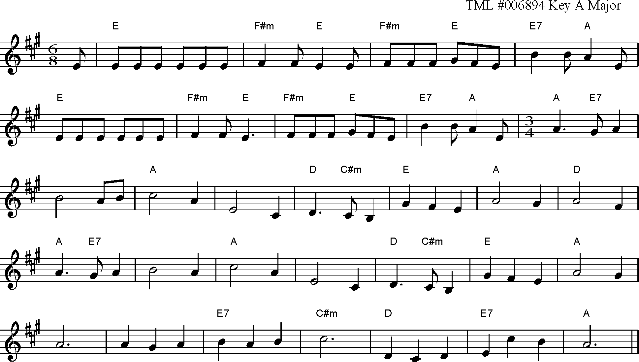|
The Mistletoe Bough (If you have come to this page from a search engine then use The midi that is playing is the music that accompanies The Mistletoe Bough.
You can get the notation for a whistle in various keys. Click here to get it. The Mistletoe Bough is said to have been taken from a true story, where for a game a bride hid from her husband in a game of hide-and-seek. Her hiding place was an old oak chest which, unknown to her, locked on a hidden spring on closing. Looking around the Internet here is some information that I found on a search for "Mistletoe Bough".Brockdish Hall, a 17 century manor is said to be the setting of the 'Mistletoe Bride'. On her wedding night, as part of a hide-and-seek game, a young bride hid in an old wooden chest with a heavy lid. She was sought high and low but not found. Only years later someone opened the chest by chance and found a mouldering corpse in bridal wear. The story is also reflected in the popular Victorian ballad, The Mistletoe Bough, by Thomas Haynes Bayley (1884). Bramwell House near Basingstoke is said to be the most haunted house in Hampshire and is also thought/claimed to be the site of the same tragedy. It is said that for 50 years the chest lay undisturbed, until one day the chest was opened and the bride was found inside a mouldering corpse. So we have two places that are claimed to be the site of the tagedy of Lord Lovell. If anyone knows which place is the actual one correctly associated with the poem and the tragedy, then please let me know. I would also like to know if you know of anywhere else that is associated with the poem or tragedy. Also, if you know it by actual fact, please let me know if Lord Lovell is just a fictional character or whether he was the actual bridegroom in both name and title. Actually, thinking about the whole affair, I find it difficult to believe or accept that an oak chest can remain untampered with for 50 years or more. It must have been discovered at some time during those 50 years, even if it had been left in an attic, and someone must have been wondered about what was in it, or must have been considered using it for something during that time. I mean, you don't just find a chest and think "Oh, that's a nice chest" and just walk away. Your curiosity makes you want to have a look in it. However, stranger things have happened than this. So it might also be worthwhile finding out if The Mistletoe Bough really did come from a true story or if it is just a story. If you have some positive proof either way then please let me know Email me at shirleyb@mc-systems.co.uk I asked
for any information that anyone could give me on the events surrounding
the Misletoe Bough song, as to whether it was written from an actual event,
and any information on that event. Anyway, here is some correspondence
that I have received on the subject.
This is the textual content of an email from Charles Tremewen I have record of a
Lord Lovell who live in Cornwall in the 1400's. Our name Hope this helps, This is the textual content of an email from Keith Sharp Hi Shirley, |
About some of the locations linked with the Mistletoe Bough mystery.
|
Norfolk: Brockdish Extract from William White's History, Gazetteer, and Directory of Norfolk 1845 BROCKDISH, on the south [ should be north ] bank of the Waveney, 2½ miles W.S.W. of Harleston, and 5 miles E. of Diss, has in its parish 466 souls, and 1054 acres of land, all freehold. John Birkbeck, Esq., is lord of the manors of Brockdish Hall and Brockdish Earl, and owner of the Hall estate, formerly the seat of the Le Grys family. T.C. Brettingham, Esq., of London, owns Brockdish Place, a handsome modern mansion, of white brick, and has a large estate here. The Grove estate, anciently the seat of the Wythes, belongs to the heirs of Mr. Thos. Walne. The Church (Saint Peter and St. Paul,) has a tower, partly rebuilt in 1714, and containing five bells. The rectory, valued in the King's Book at £10, is in the patronage of W.B. France, Esq., and incumbency of the Rev. Geo. France. M.A., who has lately erected a handsome Rectory House, in the Elizabethan style. The glebe is 25A., and the tithes have been commuted for £350 per annum. |
|
Bramshill House
Location: nr Hartley Wintney, Hampshire Origin: 18th Century Background: Since 1953 the house has been a police training college, but reference to Bramshill (Bromeselle) can be traced back to Saxon times. In 1605, Edward Lord Zouche of Harringworth became lord of the manor and demolished a large part of the building and began to build the present house. This was completed in 1612. In 1699, it passed to Sir John Cope. The ghost is thought to be a member of his family. This is the Legend of the Mistletoe Bough. Story: It was my wedding day and I was so happy. We were playing games and everyone was having fun. But it was not meant to be a happy day for me. We were playing hide and seek. I found an old chest and hid inside. Nobody could find me; I thought I had been so clever. It went quiet and I decided to get out of the chest; I assumed the others had given up. The lid wouldn't move. No matter how hard I tried it wouldn't open. I shouted and screamed but nobody came. Eventually there was no air left in the chest and I suffocated. I wander through the house hoping to find someone who can release me. |

